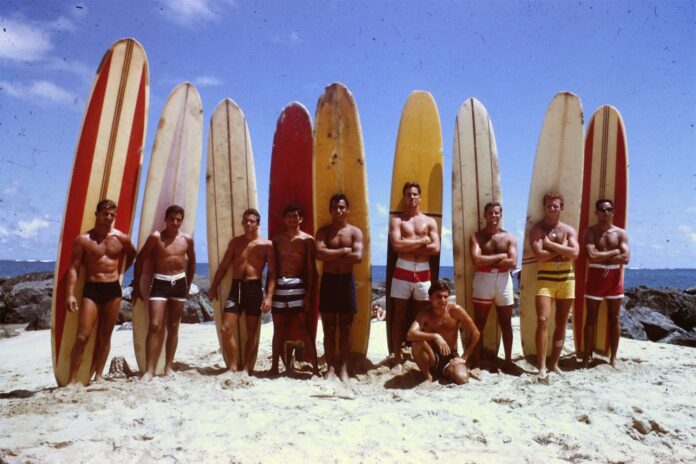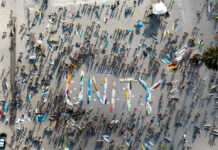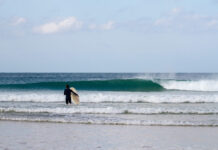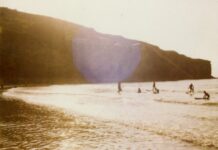Although a part of the U.S., I imagine Puerto Rico has a very distinct history and culture from most mainland states. What would you say are some of the unique elements in the history of surfing in Puerto Rico that have contributed to developing the current surf culture?
The book Atomic Surfer is the first part of a three volume series on the history and development of surfing in Puerto Rico, and although I cannot answer this question for the time being, I can say that the colonization of Puerto Rico by the United States after 1898 did create a forum, which allowed for the more rapid diffusion of a “Californicated” Hawaiian surfing to the island.
Based on your own experience and information you have come across during research, what would you say are some elements that make the surf culture in Puerto Rico unique? How different does it feel from other places you have surfed and why do you think that is?
Come to think about it, I don’t think the Puerto Rican surf culture is any different than in other places; in fact, quite the contrary. I’ll give you a few examples. When you read about the changes in California surf culture that occurred after the movie “Gidget”, it is amusing to notice many of the same social dynamics in Puerto Rico. Mickey Dora gets frustrated, angry, and violent at seeing so many people after 1959 at his favorite spot, “Malibu” – particularly after he and Mike Doyle had interacted with Kathy Kohner when they had the waves to themselves. The emergence of ‘competition’ and some degree of conflict is inevitable in all surf spots with a rapid population growth rate; it is the typical symptom of ‘overpopulation’. Given the same constant number of waves, with each new person, there are less opportunities to catch waves, and hence a greater number of conflicts in the water.
Also, the particular wave dynamics have a huge impact. For example, “Inches” (a spot in Patillas, southeastern Puerto Rico) has only one [tiny] peak, so even with 10 guys it feels crowded. By contrast, a more spread out place like “Domes” (in Rincon, on the west coast) can fit more surfers because of its different peaks. This is one good thing about big wave riding: as wave size increases, the barrier of entry is also elevated (based on merit). Thus when “La Ocho” (in Escambron, northern Puerto Rico, just off San Juan) gets big, one of the key benefits is that the number of people in the water is drastically curtailed.
The demographic composition of a spot too will have a huge impact on its given ‘spot culture’: the diversity of ethnic groups, the level of education, the level of affluence will all play a role in giving a particular spot its ‘character’. If a group is used to resolving conflicts in a violent manner on land, they will also tend to resolve conflicts in a violent manner in the water. And finally, if there are no surfers in the water, few people will get in. During the1960s, spots as #5 and #2 1/2 near Old San Juan were very popular, and now they are rarely surfed. In Mexico, five of us drove through mosquito infested jungles to get to pristine empty breaks; the lack of roads suggested that it would remain that way. So the presence or absence of surfers could be said to be a function of their number, reaching a maximum relative to wave incidence, size, and distance from the shore.
A single surfer who surfs perfects waves at some far away place but who has no audience is unlikely to continue to surf it. Surfing in this sense is deeply related to masculinity and male self-hood, which cannot occur in the absence of an audience whom will witness and testify to the events and/or personal achievements—and hence why friendship is also such an integral part of the sport. One might say that surfing helps to provide meaning to individuals who lack it in a modern social context, where so much has been removed from of our control and volition.
“Como indicó Salvador Brau, más de un 81% de los puertorriqueños vivían en la montaña, en contraste con el pequeño por ciento que vivían en las urbes tradicionales de la costa: San Juan, Ponce, Mayaguez o Aguadilla. Si consideramos la tecnología de transporte en el cual la cultura del siglo XIX se ubicaba, junto al contexto represivo colonial, el rechazo al océano en Puerto Rico empieza a hacer más sentido. (…) La interacción diaria con un fenómeno tiende a desarrollar nuestro interés y destrezas con el objeto de cercanía; mientras más distante se encuentra, menos propensos estaremos a interaccionar con el objeto debido su distancia. Aunque unas pocas millas no nos importen en el mundo del 2021 debido a la relativa facilidad y bajo costo con el cual nos podemos transportar, sin duda tal no era el caso en el Puerto Rico colonial. Cuando comparamos la experiencia borinqueña histórica con la de Hawai, cuyo núcleo de surf se encontraba en la playa de Waikiki — tan cercana y tentadora al usuario, con olas que invitaban su uso y deleite, la diferencia de experiencia es sustancial. A pesar de tener una de las mejores olas del mundo, el surfing vino a Rincón exógenamente, desde afuera, y no originó endógenamente, desde sus procesos culturales internos.”





